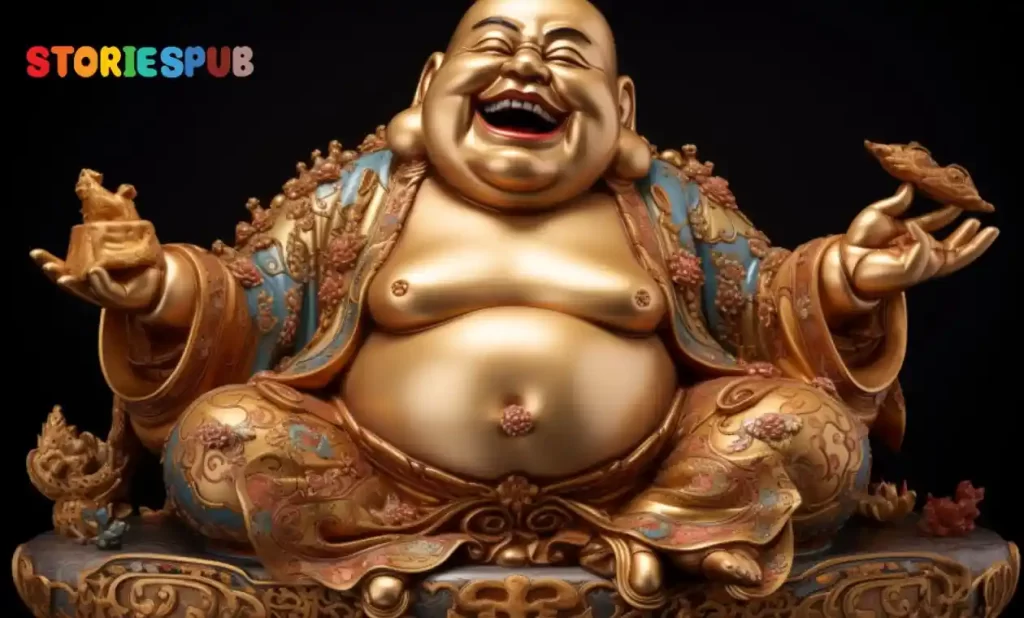Summarize this Article with:

In today’s fast-paced world, symbols of happiness and prosperity have become more important than ever, providing a much-needed source of positivity and inspiration. One such symbol that has captured the hearts of millions is the Laughing Buddha, also known as Budai. With his jovial expression and rotund belly, the Laughing Buddha has become an iconic figure in homes and offices around the globe. This article will explore the fascinating tale of the Laughing Buddha, delving into its history, symbolism, and cultural significance, as well as the practices and beliefs associated with this beloved figure.
The Laughing Buddha, or Budai, is a semi-historical figure believed to have lived around the 10th century in China. He was a Zen Buddhist monk renowned for his cheerful demeanor, compassion, and boundless generosity. Often depicted as a chubby, bald man with a big belly and a wide grin, the Laughing Buddha carries a cloth sack that is said to contain various treasures. Over time, Budai became a symbol of happiness, good fortune, and prosperity, and his image can now be found in homes, businesses, and public spaces across the world. The Laughing Buddha is not to be confused with Gautama Buddha, the founder of Buddhism, as they are two distinct figures with different historical and cultural contexts.
The history of the Laughing Buddha, or Budai
The Laughing Buddha, known as Budai or Pu-tai in Chinese, is believed to have been a real person who lived during the Liang Dynasty (907-923 AD) in China. His origins are often traced back to a Chan (Zen) Buddhist monk named Qieci, who lived near a small town called Fenghua in the province of Zhejiang. He was a wandering monk who traveled from one place to another, spreading happiness and good fortune wherever he went.
Although Budai was a monk, he did not follow the traditional monk’s lifestyle. He was known for his eccentric behavior, wearing ragged clothes, and carrying a large cloth sack filled with various items. He was often seen distributing sweets and small gifts to children, and people believed that his sack contained infinite treasures, including happiness and good fortune.
Legends surrounding Budai’s life and deeds have been passed down through generations, and over time, he came to be associated with the future Buddha, Maitreya. According to Buddhist teachings, Maitreya is the prophesied Buddha who will bring about an age of enlightenment and happiness in the future. This connection further solidified Budai’s status as a symbol of happiness and prosperity.
Connection to Chinese folklore and Zen Buddhism
Budai’s association with happiness and good fortune is deeply rooted in Chinese folklore and Zen Buddhism. The tradition of Chan (Zen) Buddhism emphasizes the importance of achieving spiritual awakening and enlightenment through meditation and mindfulness practices. Chan Buddhism also highlights the value of compassion, wisdom, and generosity, which were all traits that Budai exemplified throughout his life.
In Chinese folklore, Budai is often portrayed as a symbol of contentment and satisfaction. His cheerful demeanor and carefree attitude serve as a reminder that happiness can be found in the simplest of things, and that material wealth is not the sole source of joy and fulfillment. This message resonates with the core teachings of Zen Buddhism, which encourage individuals to let go of their attachments and desires, and to cultivate inner peace and contentment.
The Laughing Buddha’s connection to both Chinese folklore and Zen Buddhism has contributed to his widespread popularity and enduring appeal. His image has become a symbol of happiness, prosperity, and good fortune, not only in China but also in various Asian countries and around the world.
How the Laughing Buddha became a symbol of happiness and prosperity
The Laughing Buddha’s transformation into a symbol of happiness and prosperity is a result of the many stories, legends, and beliefs that have been passed down through generations. These narratives highlight his acts of kindness, generosity, and wisdom, which have inspired people across cultures to embrace his teachings and incorporate his image into their daily lives.
One popular legend tells the story of Budai’s endless generosity. As he traveled from town to town, he would carry a cloth sack filled with various treasures, such as gold coins, precious gems, and food. He would distribute these items to the poor and needy, bringing happiness and relief to those who were suffering. This act of kindness earned him the nickname “The Giver of Treasures.”
In another tale, Budai was once asked by a fellow monk about the meaning of happiness. Instead of giving a direct answer, Budai simply laughed heartily and continued on his journey. This response was not only an expression of his own contentment but also a reminder that happiness is a state of mind that cannot be captured by words or material possessions. Budai’s laughter became an embodiment of pure joy and happiness, and people began to associate his image with these positive emotions.
The Laughing Buddha’s connection to Maitreya, the future Buddha, also contributed to his status as a symbol of happiness and prosperity. Maitreya is prophesied to bring about an age of enlightenment and happiness in the future, and Budai’s association with Maitreya further elevated his importance as a figure of hope and positivity.
Over time, the stories and legends of Budai’s good deeds, cheerful disposition, and profound wisdom spread across China and other Asian countries, and his image began to be incorporated into various art forms, including paintings, sculptures, and amulets. As his popularity grew, people started to believe that displaying his image in their homes and businesses would bring good fortune, happiness, and prosperity.
Today, the Laughing Buddha remains an enduring symbol of happiness and prosperity across cultures, transcending religious and geographical boundaries. His presence serves as a constant reminder that true happiness lies within ourselves, and that acts of kindness and generosity can bring joy and contentment to both the giver and the receiver.
Laughing Buddha vs Gautama Buddha:
The Laughing Buddha and Gautama Buddha are often confused due to their similar names and the common association with Buddhism. However, these two figures are distinct in their origins, teachings, and representations. Here are some key differences between the Laughing Buddha and Gautama Buddha:
Historical Background:
Laughing Buddha: The Laughing Buddha, also known as Budai or Hotei, is believed to be a Chinese Zen monk who lived around the 10th century CE. He is often depicted as a cheerful, rotund figure with a large belly, embodying happiness, contentment, and abundance. The Laughing Buddha is not considered a founder of any Buddhist tradition but is revered for his joyous spirit and the positive energy he represents.
Gautama Buddha: Gautama Buddha, also known as Siddhartha Gautama or Shakyamuni Buddha, is the historical founder of Buddhism. He was born in Lumbini (present-day Nepal) around the 5th century BCE and achieved enlightenment under the Bodhi Tree in Bodh Gaya, India. Gautama Buddha’s teachings form the foundation of Buddhist philosophy and practice, focusing on the Four Noble Truths and the Noble Eightfold Path.
Physical Appearance:
Laughing Buddha: The Laughing Buddha is typically depicted as a plump, bald man with a large belly, wearing a loose robe and carrying a cloth sack. He is often shown with a wide, joyful smile, symbolizing happiness, contentment, and the ability to laugh at the impermanence of life. His large belly represents abundance, good fortune, and prosperity.
Gautama Buddha: Gautama Buddha is usually portrayed as a serene, slender figure with elongated earlobes, a topknot or “ushnisha” on his head, and a mark on his forehead called the “urna.” These features represent wisdom, spiritual attainment, and the capacity for infinite compassion. He is often depicted in meditation, with his hands in various mudras or symbolic gestures.
Symbolism:
Laughing Buddha: The Laughing Buddha symbolizes happiness, prosperity, and good fortune. He is often associated with the idea of attracting wealth and abundance into one’s life. His image is commonly used as a talisman for bringing positive energy and is often placed in homes and businesses to promote happiness, well-being, and financial success.
Gautama Buddha: Gautama Buddha represents enlightenment, wisdom, and compassion. His teachings focus on the path to spiritual liberation and the cessation of suffering. The image of Gautama Buddha serves as a reminder of the potential for inner peace and awakening that exists within every individual.
While the Laughing Buddha and Gautama Buddha are both important figures in Buddhist culture, they have distinct historical backgrounds, appearances, and symbolisms. The Laughing Buddha represents happiness, prosperity, and good fortune, while Gautama Buddha embodies enlightenment, wisdom, and compassion. Understanding these differences can help to appreciate the unique roles that each figure plays in the diverse world of Buddhist tradition and practice.
Differences between the Laughing Buddha and Gautama Buddha
While both the Laughing Buddha and Gautama Buddha hold significant importance in Buddhism, they are two distinct figures with different historical backgrounds, appearances, and teachings. Here, we will explore the key differences between these two influential personalities:
Historical background: The Laughing Buddha, also known as Budai, is believed to have been a wandering Zen Buddhist monk named Qieci who lived during the Liang Dynasty (907-923 AD) in China. In contrast, Gautama Buddha, or Siddhartha Gautama, was a prince who lived in present-day Nepal around the 5th century BCE. He renounced his worldly life in pursuit of spiritual enlightenment and eventually founded Buddhism.
Appearance: The Laughing Buddha is typically depicted as a rotund, bald man with a large belly and a wide, joyful grin. He is often shown wearing ragged robes and carrying a cloth sack filled with various treasures. On the other hand, Gautama Buddha is generally portrayed as a slender figure with a serene expression, a topknot or “ushnisha” on his head, and elongated earlobes. He is often depicted seated in a meditative posture, with one hand touching the earth and the other resting in his lap.
Symbolism: The Laughing Buddha represents happiness, prosperity, and good fortune. He is known for his carefree attitude and boundless generosity, embodying the virtues of contentment, compassion, and selflessness. In contrast, Gautama Buddha symbolizes spiritual enlightenment, wisdom, and inner peace. His teachings focus on the Four Noble Truths and the Eightfold Path, which provide guidance on how to overcome suffering and achieve spiritual liberation.
Role in Buddhism: The Laughing Buddha is closely associated with Zen Buddhism and is revered as an embodiment of happiness and the spirit of generosity. Some people believe that he is a manifestation of the future Buddha, Maitreya, who will usher in an age of enlightenment and happiness. Conversely, Gautama Buddha is considered the founder of Buddhism and is venerated as the “Enlightened One” who discovered the path to spiritual awakening and shared his insights with the world.
Religious practices: Devotees often rub the belly of the Laughing Buddha statues for good luck and place them in their homes or businesses to attract happiness and prosperity. In contrast, Gautama Buddha is worshipped through various practices, such as meditation, prayer, and offerings, which aim to cultivate spiritual awareness and inner peace.
In summary, while both the Laughing Buddha and Gautama Buddha hold important roles in Buddhism, they are distinct figures with different backgrounds, appearances, and symbolic meanings. The Laughing Buddha is a symbol of happiness and prosperity, while Gautama Buddha represents spiritual enlightenment and the path to overcoming suffering.
Popular legends associated with the Laughing Buddha
The sack of endless treasures:
The legend of the Laughing Buddha’s sack of endless treasures is an enchanting tale that has captivated people for generations. This story not only exemplifies the boundless generosity of the Laughing Buddha but also serves as an inspiring reminder of the importance of giving without expecting anything in return.
According to the legend, the Laughing Buddha, also known as Budai, was a wandering Zen Buddhist monk who carried a large cloth sack wherever he went. This sack, which appeared worn and humble, was said to contain an infinite number of treasures that never seemed to diminish, no matter how much Budai gave away.
As the Laughing Buddha traveled from village to village, he would distribute the treasures from his sack to the poor, the needy, and anyone who required assistance. These treasures took various forms, including gold coins, precious gems, and food, which he would generously share with those who crossed his path. His selfless acts of giving brought happiness and relief to countless people who were struggling with poverty, hunger, and other hardships.
The Laughing Buddha’s generosity was not limited to material possessions. He was also known to share his wisdom and spiritual teachings with those who sought guidance, offering them a different kind of treasure that could help them find inner peace and contentment.
In addition to highlighting the Laughing Buddha’s generosity, the legend of the sack of endless treasures also serves as a metaphor for the inexhaustible nature of love, compassion, and kindness. It reminds us that when we give selflessly to others, the positive energy we generate is boundless and has the power to create happiness, prosperity, and good fortune in our lives and the lives of those around us.
The tale of the Laughing Buddha’s sack of endless treasures has become an integral part of his legacy, reinforcing his role as a symbol of happiness and prosperity. By sharing his treasures with those in need, the Laughing Buddha taught the world a valuable lesson about the power of generosity and the importance of cultivating a compassionate heart.
The encounter with a robber:
The story of the Laughing Buddha’s encounter with a robber is a powerful illustration of the transformative power of compassion and generosity. This tale not only showcases the Laughing Buddha’s unwavering kindness but also demonstrates how a single act of compassion can have a profound impact on another person’s life.
As the legend goes, the Laughing Buddha, or Budai, was traveling from one village to another when he crossed paths with a robber. Instead of panicking or attempting to escape, the Laughing Buddha greeted the robber with a warm smile and a calm demeanor, surprising the would-be thief with his fearlessness and serenity.
Curious and intrigued by the Laughing Buddha’s reaction, the robber asked him what he had in his sack, expecting to find valuable treasures. The Laughing Buddha kindly offered the robber the contents of his sack, which, as the legend of the sack of endless treasures suggests, contained an abundance of gold coins, gems, and food.
The robber, astonished by the Laughing Buddha’s unexpected act of generosity, was deeply moved and humbled by the experience. He realized that the Laughing Buddha’s kindness was more valuable than any material possessions he could steal. This profound realization led the robber to change his ways and renounce his life of crime. He decided to become a follower of Buddhism, seeking to learn from the Laughing Buddha’s teachings and embody the virtues of compassion, wisdom, and generosity.
This encounter between the Laughing Buddha and the robber serves as a powerful reminder of the transformative power of compassion and the importance of cultivating a generous spirit. The story teaches us that by facing adversity with kindness and understanding, we can touch the hearts of others and inspire positive change, even in the most unlikely circumstances.
The legend of the Laughing Buddha’s encounter with a robber is a testament to the resilience of the human spirit and the potential for redemption and growth that lies within each of us. It is a timeless story that encourages us to embrace compassion and generosity, reminding us that these virtues have the power to change not only our own lives but also the lives of those around us.
Top of Form
The laughing contest:
The story of the Laughing Buddha’s laughing contest is a delightful and thought-provoking tale that highlights the importance of living in the present moment and finding joy in simple things. This narrative demonstrates how laughter can be a powerful tool for overcoming negativity and embracing happiness in our daily lives.
According to the legend, the Laughing Buddha, or Budai, came across a group of people who appeared troubled and weighed down by their worries and concerns. Wanting to help them rediscover the joy of laughter, the Laughing Buddha proposed a unique contest: a laughing competition with a single rule. The participants had to laugh without thinking about their problems or dwelling on their negative thoughts.
As the contest began, the participants found it incredibly challenging to let go of their worries and immerse themselves in the simple act of laughter. They struggled to genuinely laugh without being consumed by their anxieties and fears. However, as the competition continued, some participants gradually learned to let go of their negative thoughts and embrace the present moment, finding genuine happiness and amusement in the process.
Witnessing the transformation in the participants, the Laughing Buddha’s contagious laughter spread throughout the group, filling the air with joy and lightheartedness. The once somber atmosphere was replaced with an infectious energy that lifted everyone’s spirits.
The story of the Laughing Buddha’s laughing contest serves as a powerful reminder of the importance of living in the present moment and finding joy in simple things. It teaches us that laughter can be a potent antidote to negativity, and by letting go of our worries and anxieties, we can create space for happiness and positivity in our lives.
This tale also emphasizes the value of mindfulness and the power of being fully present in the moment. By focusing on the here and now, rather than getting lost in our thoughts and concerns, we can cultivate a deeper appreciation for life’s simple pleasures and experience a more profound sense of joy and contentment.
In essence, the story of the Laughing Buddha’s laughing contest is a timeless lesson in the power of laughter, the importance of living in the present moment, and the transformative potential of finding joy in life’s simple pleasures.
Celebrating the Laughing Buddha
Chinese New Year: In many Asian countries, the Laughing Buddha plays a significant role during the Chinese New Year celebrations. People believe that starting the year with the Laughing Buddha’s image will bring good fortune, happiness, and prosperity. They clean and decorate their homes with Laughing Buddha statues, paintings, and other artifacts to welcome the positive energy associated with him.
Wesak Day: Wesak Day, also known as Buddha’s Birthday, is an important Buddhist festival celebrated in many countries. Although the day primarily commemorates the birth, enlightenment, and passing of Gautama Buddha, some devotees also pay homage to the Laughing Buddha on this day. They believe that his presence can attract happiness and good fortune, and his image is often displayed prominently during the festivities.
Hotei Festival: In Japan, a festival called Hotei Matsuri is celebrated in honor of the Laughing Buddha, who is known as Hotei in Japanese culture. This festival usually takes place in November, and people participate in various activities, such as parades, performances, and food offerings, to seek blessings from Hotei for happiness and prosperity in the coming year.
These legends and celebrations showcase the widespread popularity and cultural significance of the Laughing Buddha. His image and teachings continue to inspire people across different cultures, promoting the values of happiness, compassion, and generosity.
Beliefs and Practices:
Rubbing the Laughing Buddha’s Belly for Good Luck:
One popular belief associated with the Laughing Buddha is that rubbing his belly can bring good luck, prosperity, and happiness. This practice is rooted in the idea that the Laughing Buddha’s large belly symbolizes abundance, wealth, and contentment. By rubbing his belly, people hope to activate and attract these qualities into their lives.
This custom is often practiced in homes, offices, and businesses, where people keep a Laughing Buddha statue and rub its belly as a part of their daily routine or when they feel the need for an extra dose of good fortune. It is believed that the more you rub the Laughing Buddha’s belly, the more luck and positive energy you will receive in return.
Proper Placement of Laughing Buddha Statues in Homes and Offices:
The placement of a Laughing Buddha statue is essential to harness its positive energy and bring good fortune to your home or workplace. Here are some tips for positioning a Laughing Buddha statue in your space:
Height: Place the statue at a height where it can be easily seen and revered, ideally at eye level or slightly above. This ensures that the positive energy it emanates can flow throughout the room.
Facing the entrance: Position the Laughing Buddha statue so that it faces the main entrance of your home or office. This allows the statue to greet and bless everyone who enters the space, attracting happiness and prosperity.
Living room or office: The Laughing Buddha is often associated with attracting wealth and good fortune, making it a suitable addition to living rooms and offices. Placing the statue in these areas can help to create a positive atmosphere and encourage success in both personal and professional endeavors.
Avoid bedrooms and bathrooms: It is considered disrespectful to place a Laughing Buddha statue in bedrooms or bathrooms, as these areas are associated with rest and privacy. Instead, choose a more public space where the statue can be easily seen and appreciated by all.
Clean and respectful surroundings: Ensure that the area around your Laughing Buddha statue is clean, well-maintained, and free from clutter. This shows respect for the symbol and allows the positive energy it radiates to flow freely throughout your space.
By following these guidelines for placing a Laughing Buddha statue in your home or office, you can harness its positive energy and create an atmosphere of happiness, prosperity, and good fortune.
Superstitions and Taboos:
Common Superstitions Surrounding the Laughing Buddha:
While the Laughing Buddha is primarily seen as a symbol of happiness, prosperity, and good fortune, there are some superstitions that have developed around it. These beliefs often stem from cultural or regional customs and may vary depending on local practices. Some common superstitions include:
Gifting a Laughing Buddha: It is believed that receiving a Laughing Buddha statue as a gift can bring more luck and good fortune than purchasing one for yourself. This idea is rooted in the notion that the positive energy of the statue is magnified when it is given with love and good intentions.
Number of Laughing Buddhas: Some people believe that having a specific number of Laughing Buddha statues can bring additional luck or fortune. For example, having six Laughing Buddhas in your home is thought to attract blessings for all aspects of life, such as career, love, health, and wealth.
Facing a specific direction: In certain cultures, it is believed that the Laughing Buddha statue should face a specific direction to maximize its positive energy. For example, in some Chinese traditions, it is thought that the statue should face east, as this direction is associated with good luck and prosperity.
Taboos to Avoid When Displaying or Handling a Laughing Buddha Statue:
When displaying or handling a Laughing Buddha statue, it is important to treat it with respect and reverence, as it represents a spiritual figure and a symbol of happiness and prosperity. To ensure that you maintain a positive relationship with the Laughing Buddha, consider the following taboos:
Inappropriate placement: As mentioned earlier, avoid placing the Laughing Buddha statue in bedrooms, bathrooms, or other areas associated with rest or privacy. It is considered disrespectful and may diminish the statue’s positive energy.
Placing the statue on the ground: Do not place the Laughing Buddha statue directly on the ground or floor, as this is seen as disrespectful. Instead, position it on a raised surface, such as a shelf, table, or pedestal, to show reverence and respect.
Displaying damaged statues: If a Laughing Buddha statue becomes damaged, it is considered inauspicious to continue displaying it, as the broken statue may no longer effectively channel positive energy. In such cases, it is best to respectfully replace the damaged statue with a new one.
Disrespectful handling: When handling a Laughing Buddha statue, treat it with care and respect. Avoid using it as a toy or casually tossing it around, as this may be seen as disrespectful and could negatively impact the statue’s positive energy.
By being mindful of these superstitions and taboos surrounding the Laughing Buddha, you can ensure that your relationship with this symbol of happiness and prosperity remains positive and harmonious.
Cultural Significance:
The Laughing Buddha’s Role in Different Asian Countries:
The Laughing Buddha, or Budai, has a prominent role in the cultural and spiritual landscape of several Asian countries. His image transcends national boundaries and can be found in various forms of art, religious practices, and popular culture. Here are some examples of the Laughing Buddha’s cultural significance in different Asian countries:
China: The Laughing Buddha is deeply rooted in Chinese culture and is often associated with happiness, prosperity, and good fortune. He is believed to be a Chinese Zen monk named Budai, who lived around the 10th century CE. In Chinese folklore, Budai is considered a symbol of contentment and abundance and is often associated with the Maitreya, the future Buddha.
Japan: In Japan, the Laughing Buddha is known as Hotei and is one of the Seven Lucky Gods in Japanese mythology. Hotei is revered as the god of happiness, contentment, and abundance. His image can be found in Japanese art, religious sculptures, and amulets, where he is depicted as a cheerful, rotund figure carrying a large sack filled with treasures.
Southeast Asia: In countries such as Thailand, Vietnam, and Indonesia, the Laughing Buddha is revered for his joyous spirit and is often associated with bringing good luck and prosperity. His image can be found in homes, businesses, and temples, where people pay their respects and seek his blessings for happiness and abundance.
Influence on Modern Pop Culture:
The Laughing Buddha’s joyful and distinctive image has had a significant impact on modern pop culture, both in Asia and around the world. His likeness has been adapted and reinterpreted in various forms of media, including:
Art and design: The Laughing Buddha’s iconic image can be found in contemporary art, design, and fashion. His likeness has inspired paintings, sculptures, prints, clothing, and jewelry, reflecting his enduring cultural significance and appeal.
Books and films: The Laughing Buddha has been featured in numerous books, films, and television shows, often as a symbol of happiness, good fortune, and spiritual wisdom. His character and stories have inspired both fictional and non-fiction works, showcasing his cultural relevance and widespread appeal.
Commercial products: The Laughing Buddha has been incorporated into a wide range of commercial products, including home décor, gifts, and even as a mascot for businesses. His image is often used to promote happiness, prosperity, and good fortune, making him a popular choice for marketing and branding purposes.
Tattoos and body art: The Laughing Buddha has become a popular subject for tattoos and body art, with many people choosing his image as a symbol of happiness, abundance, and personal transformation. His iconic appearance makes for a visually striking and meaningful tattoo design.
The Laughing Buddha has a significant cultural role in various Asian countries and has made a lasting impact on modern pop culture. His image transcends national boundaries and continues to inspire art, design, and various forms of media, serving as a symbol of happiness, prosperity, and spiritual wisdom for people around the world.
Art and Sculpture:
Depictions of the Laughing Buddha in Various Art Forms:
The Laughing Buddha’s iconic image has been represented and celebrated in various art forms throughout history and across cultures. Some examples of these artistic depictions include:
Paintings: The Laughing Buddha has been a popular subject in traditional and contemporary paintings. Artists often portray him with his characteristic rotund belly, jovial expression, and large sack filled with treasures, emphasizing his role as a symbol of happiness and abundance.
Sculptures: In temples and religious sites, the Laughing Buddha can be found in the form of sculptures made from various materials such as stone, wood, and bronze. These sculptures often depict him seated or standing with his hands raised, inviting good fortune and positive energy.
Wall murals and frescoes: The Laughing Buddha’s image has been incorporated into wall murals and frescoes, particularly in religious settings. These large-scale artworks often feature intricate details and rich colors, showcasing the Buddha’s joyful spirit and positive energy.
Carvings: The Laughing Buddha has been the subject of intricate carvings on various materials such as wood, stone, and ivory. These carvings often feature detailed depictions of the Buddha’s facial expressions, clothing, and accessories, highlighting his distinctive appearance and symbolic significance.
Ceramics and pottery: Ceramic and porcelain figurines of the Laughing Buddha have been crafted in many Asian countries, often featuring vibrant colors and intricate designs. These decorative pieces are popular as home décor and gifts, reflecting the Buddha’s widespread appeal and cultural significance.
Common Materials Used for Laughing Buddha Statues and Figurines:
The Laughing Buddha has been represented in numerous materials, each with its unique properties and aesthetic appeal. Some of the most common materials used for Laughing Buddha statues and figurines include:
Bronze: Bronze statues of the Laughing Buddha are highly valued for their durability, detail, and patina. These statues often feature intricate designs and can range in size from small tabletop figurines to large outdoor sculptures.
Resin: Resin is a popular material for making Laughing Buddha statues, as it is lightweight, affordable, and versatile. Resin statues can be crafted with great detail and can be painted or finished to resemble other materials such as bronze or wood.
Wood: Wooden Laughing Buddha statues are highly valued for their natural beauty and craftsmanship. Woodcarvers often use various types of wood, such as teak, rosewood, or sandalwood, to create statues that showcase the material’s unique grain patterns and colors.
Stone: Stone statues of the Laughing Buddha, made from materials such as marble or granite, are durable and elegant. Stone carvings often feature a high level of detail and can be displayed indoors or outdoors as garden ornaments.
Porcelain and ceramics: Porcelain and ceramic Laughing Buddha figurines are popular for their delicate beauty and vibrant colors. These figurines can be glazed or unglazed and often feature intricate designs and patterns, reflecting the skill and artistry of the craftsmen who create them.
The Laughing Buddha’s enduring appeal and symbolic significance have inspired a diverse range of artistic representations and materials. These various art forms and materials contribute to the richness and variety of the Laughing Buddha’s cultural legacy, making him a beloved and enduring figure across cultures and time.
Conclusion
In conclusion, the Laughing Buddha, or Budai, has been a cherished symbol of happiness, prosperity, and good fortune for centuries. With roots in Chinese folklore and Zen Buddhism, this jovial figure has transcended national boundaries and become an integral part of the cultural and spiritual landscape of several Asian countries. His distinctive appearance, engaging legends, and the various beliefs and practices associated with him have captivated the hearts of people worldwide.
Artists have been inspired by the Laughing Buddha’s joyful spirit, creating various forms of art, sculpture, and design that celebrate his symbolic significance. The Laughing Buddha’s influence on modern pop culture is undeniable, as he continues to be featured in books, films, and commercial products.
As a reminder of the importance of living in the present moment, embracing happiness, and cultivating a generous spirit, the Laughing Buddha remains a beloved figure for people of diverse backgrounds and beliefs. His enduring appeal serves as a testament to the universal desire for happiness, abundance, and spiritual wisdom.
Hey kids, how much did you like The Tale of the Laughing Buddha: A Symbol of Prosperity? Please share your view in the comment box. Also, please share this story with your friends on social media so they can also enjoy it, and for more such Chinese Mythology, please bookmark storiespub.com.
Related Post :
FAQ about Laughing Buddha
Who is the Laughing Buddha?
The Laughing Buddha, also known as Budai, is a popular symbol of happiness, prosperity, and good fortune in Chinese and Zen Buddhist culture. He is often depicted as a cheerful, rotund monk carrying a sack filled with treasures.
Is the Laughing Buddha the same as Gautama Buddha?
No, the Laughing Buddha and Gautama Buddha are not the same. The Laughing Buddha is believed to be a Chinese Zen monk named Budai, while Gautama Buddha is the founder of Buddhism who lived in ancient India.
Why is the Laughing Buddha associated with happiness and prosperity?
The Laughing Buddha's jovial demeanor, legends of his boundless generosity, and his association with good fortune have made him a popular symbol of happiness and prosperity in various Asian cultures.
How should I place a Laughing Buddha statue in my home or office?
To attract good luck and prosperity, place the Laughing Buddha statue facing the entrance of your home or office, preferably on an elevated surface. Avoid placing the statue in the bedroom or bathroom.
What is the significance of rubbing the Laughing Buddha's belly?
Rubbing the Laughing Buddha's belly is believed to bring good luck, happiness, and prosperity. This practice has its roots in Chinese folklore and is thought to spread positive energy.
What are some popular legends associated with the Laughing Buddha?
Some popular legends include the tale of the Laughing Buddha's sack of endless treasures, his encounter with a robber, and the laughing contest where he challenged people to laugh without thinking about their worries.
Are there any taboos surrounding the Laughing Buddha?
Yes, there are some taboos. For example, you should not place the Laughing Buddha statue on the floor, in the bedroom, or in the bathroom. It is also considered disrespectful to use his image on items like doormats or ashtrays.
What materials are commonly used to create Laughing Buddha statues and figurines?
Common materials include bronze, resin, wood, stone, porcelain, and ceramics. Each material offers a unique aesthetic and durability.
Is the Laughing Buddha considered a religious or spiritual figure?
Yes, the Laughing Buddha is often associated with Chinese and Zen Buddhist beliefs. However, his appeal transcends religious boundaries, and many people view him as a symbol of happiness and prosperity without a specific religious affiliation.
How has the Laughing Buddha influenced modern pop culture?
The Laughing Buddha has influenced pop culture through various forms of media, including art, design, books, films, and commercial products. His image has been adapted and reinterpreted in numerous ways, reflecting his enduring cultural significance and appeal.
















